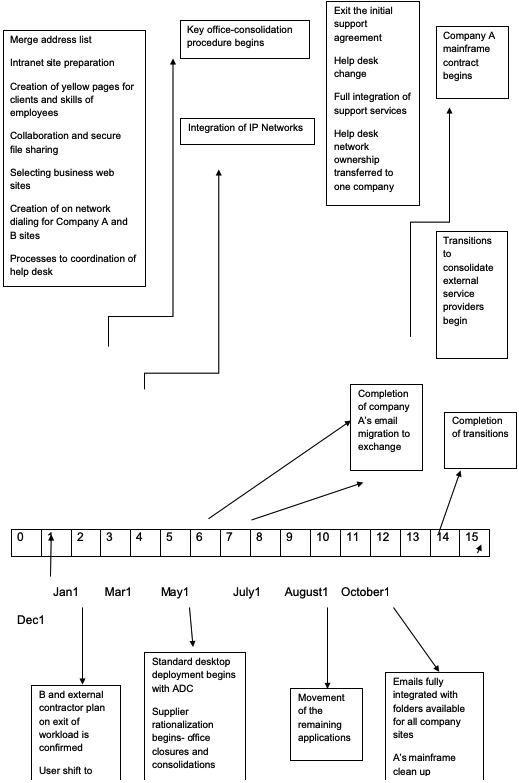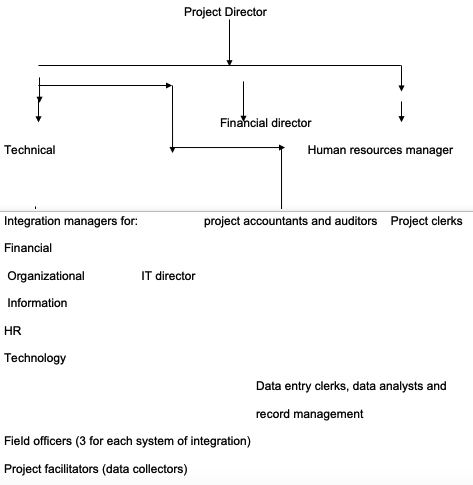Scope of statement
Since its inception, Navigant Consulting has been involved in a variety of corporate investigative activities and management consulting. The firm has the obligation of supporting the corporate sector, as this market segment forms the company’s client base through offering consultancy services. Navigant Consulting aims at establishing an effective model through which merging companies can implement synergies to ensure savings on gross costs.
Supporting mergers through the integration of some systems and processes of the two companies forms the pillar of Navigant in relation to consultancy services on management. With reference to this pillar, the company has launched Intercompany Net Project to help in the enhancement of the process of mergers for companies across the world.
Navigant Consulting has the vision of broadening the scope of mergers by 2019 through forming partnerships with private companies to address different issues in relation to the process of merging. The Intercompany Net Project entails increasing cost savings for integrated companies through the integration of five areas that include human resource systems, financial systems, organizational integration, and information and technology integration (Project Management Institute, 2008). The concept of this paper will incorporate the identification of different ways through which consolidation and standardization of the networks of two merging companies can occur, as provided by the Navigant Consulting.
Additionally, Navigant approximates the generation of cost savings significantly from the variables involved in the process of integration. The company also recognizes the soaring competition and rising costs of operation, hence the need to implement measures to ensure the reduction of costs of operations. The implementation of the project should occur in the next five years and the company is keen to apply practical approach to theories incorporated in the project to facilitate cost saving of merging companies through the integration of the five systems.
Schedule for the project
The Intercompany Net Project began in January 2009 and it would take a period of one year. However, the project would be implemented in four companies within the duration of four years for pilot studies. Analysis of the project would occur after five years and recommendations given.
Outline of activities

Human resource plan for the project
The huge size of the project requires the application of significant amounts of human capital. For the project director, the person heads and supervises the overall project. Immediately under the project director are the financial director, technical directors, and the manager in charge of human resources. The financial director handles financial issues like supervising to ensure that finances are used to facilitate the intended activities.
The technical director deals with the determination of the project performance depending on the stages of implementation (Project Management Institute, 2008). For the human resource manager, he or she is charged with recruiting junior staff members to facilitate and work on the project. Under the technical director are the integration managers for financial, organizational, HR, information, and technology.
The integration managers are involved in the study of the project for the period of five years, thus managing the process of integration. For each system, there are three field officers working under the supervision of integration manager. Further, integration officers work with project facilitators, whose work involves the collection of data. Under the human resource manager are the project clerks. These individuals are charged with reporting HR needs to the HR manager.
Further, their roles are supervisory, but they are charged with analyzing data for the project at the end of five years. Intercompany Net Project is set to run at a cost of half a million dollars. The stringent budget aims at reducing the rate of administrative expenses, thus saving funds for the main project. Although some recurrent expenses may increase due to the long duration of the project, the human resources manager is expected to hire adequate staff members to ensure saving on costs.

Overview of the company
Toward the end of the 20th century in 1999, a global consultancy company dealing with management issues in regulated industries was founded. Navigant consulting was initially named the Metzler Group, which was formed by Richard Metzler at the start of the 1980s. However, towards the mid-1999, the shareholders approved the change of the company’s name to Navigant Consulting. From inception, Navigant Consulting specialized in management issues through helping clients navigate the evolving business environment. The company emphasizes the development of consolidation programs that would facilitate operations of merging companies through the integration of their systems.
Navigant Consulting focuses on the need to offer integration solutions to companies with a view of increasing cost savings and facilitating performance of the merging companies through eliminating the duplication of duties. Navigant Consulting works improve cost savings in merging companies through offering consultancy services to enhance management processes and systems of two companies that are operating as one. Such methods involve the incorporation of management approaches to ensure a reduction in the cost of running the companies daily.
Navigant Consulting works with the private investors to facilitate the execution of its mandate. In most circumstances, the company engages in the production of programs to facilitate mergers amongst companies. According to the company, the high cost of facilitating mergers and operations of the merged company hampers the formation of partnerships among companies. With reference to this aspect, the company researches on efficient programs that would facilitate sustainability in the operations of merged companies with an object of reducing cost of operations.
Current project practices at Navigant Consulting
From the inception of Navigant Consulting, the company has implemented various programs other than the Intercompany Net Program. However, the numerous programs define the uniqueness of Navigant’s programs and actions. Prior to the implementation of programs, Navigant has to ensure that the program contributes to the economic viability of both Navigant and the client. However, programs are flexible and can be altered to ensure that the project helps to achieve the targeted percentage of cost savings.
Planning entails a significant process through which companies ensure that they have sufficient resources prior to the implementation of the project. For Navigant, the company has a large pool of employees with different skills and knowledge, hence a diversified labor force. Further, the company embraces the model of practical planning with the designing programs defining the start of the project. Designing of programs entails stating a framework through which operations are defined (Project Management Institute, 2008). From the framework, duties of various people involved in the implementation of the project are defined and revised to eliminate the duplication of duties.
Additionally, this stage enhances efficiency through ensuring that different people know their duties and timelines by which targeted outcomes should be achieved. The Intercompany Net Project is a product of comprehensive planning that incorporates various doctrines of management to facilitate success of the project (Kloppenborg, 2014). For example, the project incorporates the consolidation of some common operations of merging companies to form a common system that operates as one. Such a process eliminates the duplication of duties in the organization, thus reducing costs of operations.
The success or performance of projects depends on the rate of evaluation. Highly supervised projects have high probabilities of success, as employees are alert in their work and keen to achieve targets within some given deadlines (Kloppenborg, 2014). For Navigant, the project manager evaluates whether or not the project has been implemented within the given timelines. Furthermore, the project manager reviews the process of implementation to ensure that all processes were incorporated. From this point, the manager identifies what needs to be changed and enhanced in a bid to improve efficiency of the project.
However, the project manager works within his or her mandates as set by the executive management of Navigant. In the stipulation of the company’s structure, it is the duty of a project manager to review the progress of projects undertaken by the company, thus highlighting the comprehensive evaluation of the Intercompany Net project. Moreover, the expert opinion of the project manager must be geared toward achieving the objectives of the project. Through Navigant’s model of SWOT analysis, projects are subjected to a comprehensive analysis (Project Management Institute, 2008).
Projects cannot succeed without proper planning of the company’s fund through adequate budgeting. Budgeting ensures that the company has sufficient funds for the project and that the execution of activities does not exceed finances set aside for that purpose (Kloppenborg, 2014). For Navigant, the company collaborates with an external project consultant, who works on harmonizing resources to ensure efficiency in the appropriations of budget. The process of appropriations in Navigant begins with the analysis of financial capabilities of the company.
For the human capital, Navigant invests to significant extents in human resources in a bid to ensure that the company has adequate technical team to facilitate its projects. Furthermore, Navigant conducts routine evaluation of its current staff to ensure that employees have the relevant skills and knowledge to handle a given project. The success of the Intercompany Net Project affirms the high level of employee evaluation within Navigant. Furthermore, through the evaluation process, the HR manager identifies shortages within the current pool of employees and hires external consultants to fill the gap. In a bid to ensure that employees perform to their optimal capacity in implementing the project, Navigant rewards implementers based on their performance and competence (Kloppenborg, 2014).
Recommendations
Corporate training
Navigant should hold seminars, exhibitions, and formal training for its employees and clients to sensitize them on the use and significance of the project. For a profit-generating company, corporate training also creates a platform through which Navigant can market its project. Furthermore, Navigant assumes the responsibility of training clients so that they do not incur additional expenses as they seek advice from other external consultants.
Financial sustainability
Navigant should institute flexible parameters within the program to facilitate the manipulation of the program depending on the needs of the client. Through flexible parameters, Navigant ensures that clients do not incur additional costs in purchasing updates for the installed programs. Prior to approving the project, Navigant can assess economic feasibility of the project through comparing projected benefits against projected costs. Such comparison ensures that the client does not incur losses on implementing products of the project.
Incorporating external participation
Navigant can design a project that focuses not only on the needs of clients, but also interests of external publics, such as suppliers of the client companies and government. As a participant in the corporate sector, Navigant must recognize the significance of external publics for its operations to succeed. Such a move requires the incorporation of an engagement policy that engages the government for other external parties to develop assurance of protection of their interests. Apart from promoting interests of external parties, external participation enlightens other companies concerning new merger solutions in the market.
References
Kloppenborg, T. (2014). Contemporary Project Management. Stamford, CT: Cengage.
Project Management Institute. (2008). A guide to the project management body of knowledge. Newtown Square, PA: Project Management Institute.